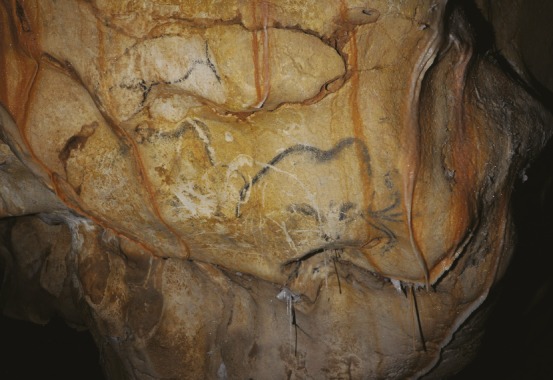Handwriting analysis hints at timing of Hebrew biblical texts

Ostraca from Arad, southern Judah, dated to ca. 600 BCE. Image courtesy of the Institute of Archaeology, Tel Aviv University, and of the Israel Antiquities Authority.
Scholars have long debated the extent of the Hebrew bible that was composed before the siege and depredation of the kingdom of Judah by the Babylonian king Nebuchadnezzar in 586 BCE. Reasoning that widespread literacy must have been required for the compilation of biblical texts, Shira Faigenbaum-Golovin et al. (pp. 4664–4669) analyzed Hebrew inscriptions on ceramic shards called ostraca, which were previously excavated from the desert fortress of Arad in southern Judah and dated to around 600 BCE. Using computerized image processing and machine learning tools, the authors analyzed 16 inscriptions and deduced that the texts were written by at least six authors. Tellingly, the inscriptions included instructions for troop movement and registration of expenses for victuals, suggesting evidence of writing ability along the military chain of command down to the fort’s deputy quartermaster. The tone and nature of the inscriptions preclude the role of professional scribes. The remoteness of Arad and its links to the kingdom’s military administration as well as the narrowly constrained ages of the ostraca together suggest that literacy was widespread among the Judahite army ranks, priests, and administrators as early as 600 BCE. According to the authors, the untrammeled spread of literacy in Judah may have set the stage for the compilation of hefty biblical works that compose the bedrock of Judahite theology. — P.N.
Reconstructing history of Chauvet-Pont d’Arc cave

Charcoal mammoth drawings from the Chauvet-Pont d’Arc cave. Image courtesy of Jean Michel Geneste (Ministère de la Culture et de la Communication, Paris, France).
The Chauvet-Pont d’Arc cave in southern France contains well-preserved and complex graphic panels of Paleolithic artwork. Initial radiocarbon dates revealed the artwork to be more than 30,000 years old, an age that is 10,000 years older than that predicted through stylistic considerations. Anita Quiles et al. (pp. 4670–4675) compiled more than 250 radiocarbon dates obtained over the past 15 years from charcoal pieces found on the cave floor, charcoal drawings and markings on the walls, and animal bones found within the cave. The dates were incorporated into statistical models to reconstruct the history of cave occupation. Dates obtained from charcoal samples on the cave floor and walls are consistent with two phases of human occupation, the first lasting from 37,000 to 33,500 years ago, and the second lasting from 31,000 to 28,000 years ago. The majority of animal bones found within the cave are traced to cave bears, and dates from these bones are consistent with cave bear occupation until 33,000 years ago, contemporary with the first human occupation phase. The end of the first human and cave bear occupations correlates with a rockfall that occurred approximately 34,500 years ago, as estimated by 36Cl dating. The end of the second human occupation correlates with a second rockfall 29,400 years ago that partially closed off the cave entrance, according to the authors. — B.D.
Future heat-related labor costs in China

Hot summer day in Beijing. Image courtesy of Wikimedia Commons/Scott Meltzer.
Heat waves, which can affect human health and occupational safety, are expected to increase in frequency due to global climate change. The Chinese government requires employers to pay high-temperature subsidies (HTSs) to workers when the daily maximum temperature exceeds 35 °C, thereby increasing the labor cost during hot weather. Yan Zhao et al. (pp. 4640–4645) estimated changes to the cost of HTSs in China over the coming century, using various climate models and assumptions about future greenhouse gas emissions, population growth, and employment rates. Assuming moderate population growth and a constant HTS rate per employee per hot day, the climate models predicted significant growth in HTS costs during the early 21st century, averaging approximately 250 billion yuan/year by the 2030s. Under the highest emissions scenario, the average predicted HTS cost continued to increase throughout the century, reaching approximately 1 trillion yuan/year by 2100. The authors estimated population growth to be the largest driver of cost increase in the early part of the 21st century, with greenhouse gas emissions becoming dominant after midcentury. The results may help guide the development of future regulations to protect workers from the heat in China and other countries, according to the authors. — B.D.
Analyzing leaf vein patterns
The growth of land plants depends on the integrity of leaf vein networks that supply water to tissues engaged in photosynthesis. But drought endangers these networks, as drying soil increases water tension in xylem cells, resulting in air embolisms that disrupt water supply and cause leaf death. To illuminate plant adaptations against catastrophic leaf network failure, Timothy Brodribb et al. (pp. 4865–4869) developed an optical technique that records rapid changes in light transmission through leaf veins to visualize the formation and spread of embolisms. The authors severed the contact between branches and soil to simulate the onset of severe drought and used a microscope to record images of leaf networks every 30 seconds. Across different fern and angiosperm species, air bubbles originated in the largest veins and spread to smaller veins. However, the pattern of vein failure varied across three types of network architecture. The findings reveal the role of vein size and network architecture in the spread of drought-induced embolism damage in leaves. According to the authors, studying how leaf vein patterns prevent water transport failure could help improve the safety of a range of man-made networks. — J.W.
How the brain adapts to stress
Stressful events often cause long-lasting behavioral responses tied to protection against psychiatric disorders such as depression and anxiety. Previous studies have shown that stress-induced behavioral adaptation depends on epigenetic modifications, chemical processes that affect gene activity without altering the DNA sequence, but the underlying mechanisms remain unclear. Using a rat model, Emily Saunderson et al. (pp. 4830–4835) found that stressful events evoke an epigenetic modification called DNA demethylation in certain genes in a brain region called the dentate gyrus. The authors allowed rats to swim for 15 minutes to induce stress, and then assessed whether the animals displayed an adaptive behavior, namely immobility, when forced to swim again for 5 minutes the next day. Before the first forced swim test, some of the rats were injected with the DNA methylation-promoting compound S-adenosyl methionine (SAM), whereas the control group did not receive this treatment. SAM enhanced DNA methylation in the c-Fos and Egr-1 genes, suppressing the genes’ activity in dentate gyrus neurons and impairing the animals’ immobility response 1 day later. The results demonstrate that the DNA methylation status of certain genes in the dentate gyrus influences stress-induced behavioral adaptation. According to the authors, the findings could lead to the development of treatments that promote appropriate behavioral responses to stress and protect against psychiatric disorders. — J.W.


